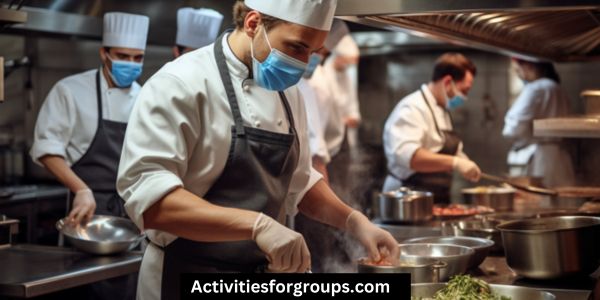Are you looking for a fun and engaging way to build team morale and collaboration? Planning a group cooking class could be the perfect way to do just that.
It’s easy to do if you know the basics – determine the goals, choose the menu, prepare the ingredients, find a venue, and ensure safety.

Follow the steps below and your corporate team will be cooking up some great memories in no time!
Determine the Goals
Deciding on the purpose of your group cooking class is essential for successful corporate team building. Before starting to plan the class, it’s important to understand the desired outcome and how the cooking class should contribute to team dynamics and group dynamics.
Define the objectives and goals for the cooking class and make sure that they’re attainable and realistic. Consider the overall team goals and how the cooking class can help achieve these objectives. Ask yourself what you want the team to take away from the class and make sure that you can measure the results.
Think about the different levels of ability among your team members and create a class that’s suitable for everyone. Establish a level playing field in terms of skills and create an atmosphere of learning and collaboration.
You can even divide the class into different teams and set a task for each team to complete, which will help strengthen their teamwork and communication skills.
The goals of the cooking class should be fun, educational, and beneficial to the team. As you plan the class, focus on making sure that everyone has a positive experience and that the team dynamics are improved and strengthened. With a clear purpose, you can ensure that your group cooking class is a success.
Choose the Menu
Once you’ve determined the goals for your group cooking class, it’s time to start choosing the menu. Invite chefs to share their recipes, or have your corporate team members review recipes online to determine the dishes they’d like to prepare. Have them decide on a main dish, side dishes, and a dessert. Here’s a table to help you plan:
| Main Dish | Side Dishes | Dessert |
|---|---|---|
| Chicken Parmesan | Roasted Brussels Sprouts & Carrots | Apple Crisp |
| Chili | Garlic Roasted Potatoes | Cheesecake |
| Lasagna | Green Salad | Carrot Cake |
| Shepherd’s Pie | Roasted Asparagus | Ice Cream |
When deciding on a menu, make sure the recipes are suitable for the skill level of your corporate team. It’s important to choose recipes that will challenge the group, but still be achievable. Once you have the menu set, you’ll be ready to start shopping for the ingredients and planning the cooking class.
Prepare the Ingredients

Once you’ve chosen your menu, it’s time to prepare the ingredients for your corporate group cooking class. To make the most of your team bonding experience, remember to factor in the time it takes to shop for ingredients, as well as the time it takes to prepare them.
Here are some tips to help you plan:
- Shopping:
- Make a list of all the ingredients you need.
- Head to the grocery store, or order online.
- Bring enough for everyone to have their own ingredients.
- Preparing:
- Have the team divide up the tasks.
- Bond over food by having everyone help out.
- Share recipes and cooking tips as you work.
Find a Venue
Once you’ve gathered the necessary ingredients and materials, it’s time to find a venue for your corporate group cooking class. When arranging seating, it’s important to have enough space for each person to have their own station. If the group is too large, you may want to consider breaking it up into smaller teams and providing multiple stations. Additionally, think about the type of recipes you’ll be selecting and make sure the venue has all the necessary equipment to accommodate them.
When selecting recipes, it’s important to choose ones that will suit the group’s skill level. If you’re dealing with a lot of novice cooks, opt for simple recipes that don’t require too much skill or technique. On the other hand, if you have a more experienced group, you can choose recipes that are a bit more complicated.
Also, take into account the time and resources you have available. If the cooking class is only an hour long, you may want to pick a simpler recipe that won’t require too much prep time. And if you have access to a professional kitchen, you can take advantage of its resources and choose a more complex dish.
Ensure Safety

Before beginning the cooking class, make sure to review basic safety procedures with your group. It’s important to create boundaries and expectations to ensure a safe and enjoyable experience for everyone. Here are a few tips to consider:
- Sanitation:
- Use fresh ingredients
- Make sure kitchen surfaces are clean
- Thoroughly wash hands for 20 seconds
- Equipment:
- Check equipment for any damage
- Ensure proper maintenance and storage
- Wear appropriate safety gear
- Virtual Instruction:
- Be aware of any technical difficulties
- Have a backup plan in case of connection issues
- Make sure everyone is comfortable with the virtual platform
Safety should always be top priority when planning a group cooking class. Taking the time to review safety procedures and create boundaries will help create a positive and enjoyable experience for all.
With the right precautions, a virtual cooking class can be a fun and engaging way to practice team building.
Frequently Asked Questions
What Is the Maximum Number of People That Can Attend the Class?
The maximum number of attendees depends on the facilitator’s experience and the duration of the class. Generally, up to 12 people can participate.
How Much Time Should Be Allocated for the Class?
You’ll need to allocate time for socializing, collaboration, and cooking. Aim for at least two hours for the class to ensure everyone has enough time to participate.
Is There an Opportunity to Customize the Menu?
Yes, you can customize the menu selection and ingredient options to fit the team’s preferences.
What Kind of Equipment Is Needed for the Class?
You’ll need basic kitchen equipment, like pots and pans, to cook the menu you select. Depending on the cooking methods, you may need more specialized items.
Are There Any Additional Costs Associated With the Class?
You’ll likely need to stock ingredients and order supplies for the class, which could incur additional costs.
Conclusion
Planning a group cooking class for corporate team building can be a great way to bring your team together and foster collaboration. With a little bit of planning, you can ensure that everyone has a great time and leaves feeling inspired and connected.
So don’t wait – get started planning your team’s group cooking class today!




Leave a Reply